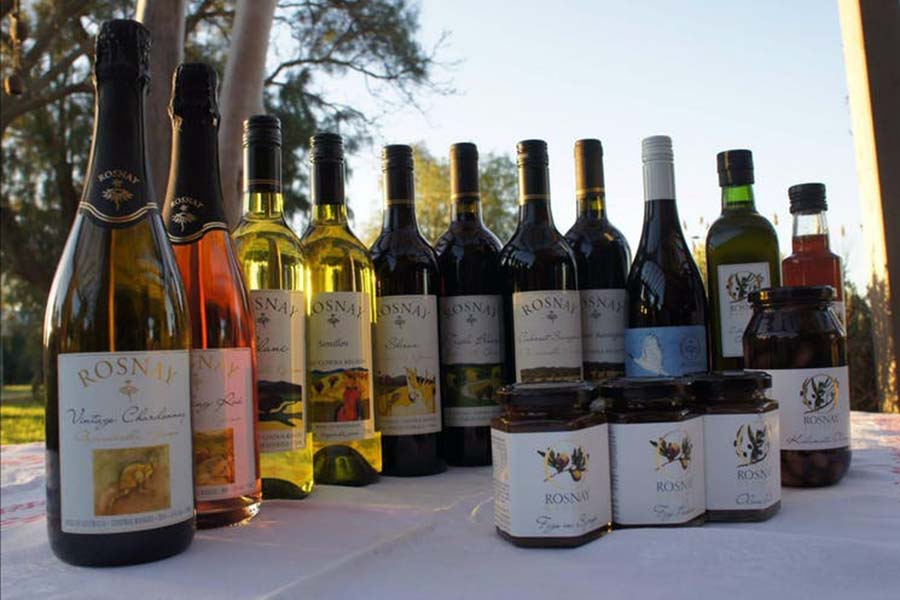An organic adventure into winemaking
Rosnay produce organic and preservative-free wines from their vineyard and orchard in NSW’s Canowindra. This is a family project through-and-through, with its origins going generations back to a French winemaker in one of France’s most lauded wine regions.
It starts in Beaujolais, where all good wines start
The Rosnay story begins in France with a man named Alberic Dulong de Rosnay, who had vines growing in Cogny, a commune in the infamous Beaujolais region of France. Alberic’s vineyard produced great wine, and his family also kept beehives, a vegetable garden, and baked their bread in an outdoor bread oven. Alberic’s daughter, Dolly, was raised on this form and went on to become a fashion designer and rally driver in France, always full of positive enthusiasm and experiential knowledge of wine-growing passed on from her father.
In 1946, Dolly gave birth to a beautiful daughter named Florence, who went on to migrate to Australia in the 70s and marry a local farmer called Richard Statham. Richard came from a family that was deeply passionate about the outdoors. His father, Clive, was a doctor and avid organic gardener who greatly adored native plants and animals. Clive passed on his deep enthusiasm for natural going to Richard, who studied agriculture , jackerooed on pioneering irrigation projects in the Ord river, served in Papua New Guinea, and ended up growing fine wool with Florence in Barraba in Northern NSW.
In 1995, the couple decided to move to a region with better soils, irrigation, and a reliable climate for a new venture. They were going back to Florence’s roots, growing grapes in an organic environment with healthy soils and using biodynamic methods. Florence and Richard ended up starting the first organic vineyard in Cowra’s wine region and establishing one of the best wines to come out of the Central Ranges.
It’s not easy to be organic
A town called Canowindra is where the couple found their home. Sloping gently towards the Belubula river, their patch had the ideal deep red water-holding clay soils and reliable continental climate and water for the vines, orchids, and olives they ended up planting over the next decade. But before they could reap the fruits of their labour, there was all the labour to be done…
The couple started by doing a farm plan, cleaning up the gullies and old fences by hand, digging 140 soil mapping pits, and planting alleyways of native trees. Everything was done using organic, bioagricultural, cell grazing, yeomans, and biodynamic methods. Slowly, they started reviving the soil organic matter and natural ecosystem of their property. And today, the Statham’s property proudly grows 20 hectares of wine grapes, 10 hectares of olives, and ½ a hectare of figs – all organic and natural as can be.
Then came the wines
It was a bold step for the couple to establish their vineyard organically before planting, and one that’s not often done. Most of today’s organic vineyards were initially set up using herbicides, but Florence and Richard carted in truckloads of compost and straw mulch and painstakingly hand-weeded their new vines rather than taking the easier road. That’s what happens when you’re passionate about great gardening and want to infuse your loving energy into the soil. The couple’s venture in Canowindra started with small beginnings, selling grapes to other organic wineries.
The business then grew ‘organically’, with the earliest Rosnay wines being made as contra deals with those wineries. They then planted olives and figs and started playing around with making larger batches of wine using contract winemaking from neighbouring wineries. In 2014, Florence and Richard made their first wines on site in their sheds. Just two years later, the couple won the Winestate organic wine of the year, and in 2017, they built a dedicated strawbale winery on the property with a focus on handpicked grapes.
An organic adventure into winemaking
The journey from simple grape growers to highly esteemed winemakes has been quite the adventure for Richard and Florence. There was a lot of experimentation and playing around with different elements to see how they impacted the flavour of the wine. There was the Oak vs No Oak argument – Florence initially thought using oak would take away from the authenticity of the wine as a flavouring can hide the true flavours of terroir. After careful experimentation, she realised that intentional use of oak, in small portions of the overall blend, can actually give gentle oxygenation and soft tannins that enhance the wines expressiveness of terroir.
Now, eight years later, their barrels are mostly old, large, formal 3-600L and a mix of about 50% steel tank, 45% old oak, and 5% new oak. The couple’s sons Sam, Nick, and Oli are also variously involved in Rosnay’s winemaking, each dabbling and bringing their own interests and expertise to the project.
But the centre of the team is and always will be Flo, creating the unique flavours and even designing the labels herself. As an avid artist, Flo uses watercolour, pastels, oils, and glazing to share the beauty of the crops and landscapes, colourful wildlife and flowing river surrounding the farm. After all, Rosnay began with Flo’s grandfather, and it makes sense that she carries that spirit on.
Read about some of the exclusive & most passionate producers in Australia in CHEFIN’s team deep dive into New South Wale’s best producers.

